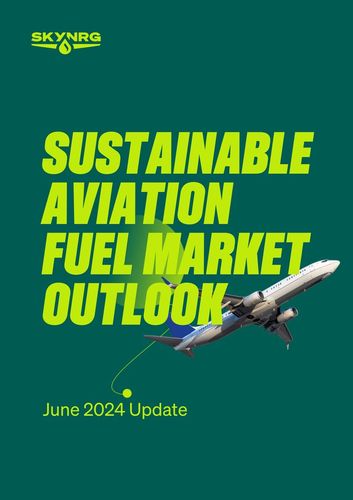SkyNRG releases SAF market outlook 2024

SOURCE: SkyNRG
June 13, 2024
BY SkyNRG
The SkyNRG Sustainable Aviation Fuel Market Outlook covers the current state and trends of the SAF market in the EU and U.K., the U.S. and rest of the world by assessing announcements of SAF projects and mapping out the capacity until 2050.
For the first time, the report is expanding to global coverage and presenting all the latest policy developments. Notably, Japan, Singapore, India, Brazil, British Columbia, Indonesia and Malaysia have developed (proposals for) legislation to drive domestic SAF uptake.
Key takeaways from the report include recognizing that SAF capacity significantly increased to a level of 17.3 Mt (5.7 Bgal) by 2030, a growth of 4.0 Mt (1.3 Bgal) compared to last year. This is driven by regulatory developments such as ReFuelEU in the EU, the U.K. mandate, but also voluntary uptake in the U..S supported by incentives.
Advertisement
Voluntary demand signals have continued to strengthen, with multiple airlines, cargo companies, and corporates setting ambitious SAF targets. These will amount to some 12 Mt (4.0 Bgal) by 2030, with overlap in the regulatory market. These purchases have been crucial to market growth over the past years, but must now translate into reliable, longer-term commitments to attract capacity above regulatory obligations.
Current global capacity announcements are dominated by the HEFA pathway, which represents ~85% of announced capacity in 2030. While co-processing makes up a smaller fraction of public announcements, we expect more projects to materialize given favorable economics and low complexity.
Alcohol-to-Jet (AtJ) facility announcements have increased to ~8% of announced 2030 capacity, supported by the commissioning of the first commercial-scale facility and clarifications to US federal tax credit greenhouse gas (GHG) methodology. All other technologies (including Fischer Tropsch, e-SAF, and others) remain a minority of announced capacity, at ~7% of 2030 capacity.
A possible stronger push for advanced pathways can be found in the increase of SAF as a globally tradeable commodity. Regions that have historically been significant exporters of feedstock, such as China and Brazil, are now looking to move up the value chain and produce renewable fuels. If mandate discussions around the world progress, particularly in China, this could restrict access to UCO, tallow and palm residue feedstock
Advertisement
Philippe Lacamp, CEO of SkyNRG says, “As a thought leader in the SAF industry, we are pleased to present our fourth edition of the Sustainable Aviation Fuel Market Outlook, providing transparent and reliable information about the SAF market.
It is encouraging to see the progress being made towards net zero in the report. The Market Outlook also highlights the importance of reliable, long-term policy environments globally to allow for capacity development planning and unlocking of the significant investments needed to enable construction and commissioning of SAF facilities.”
Related Stories
Imperial Oil Ltd. on Aug. 1 confirmed it has completed construction and commissioning of its renewable diesel project at the Strathcona refinery near Edmonton, Alberta. The facility began producing renewable diesel in July.
PBF Energy Inc. on July 31 announced the St. Bernard Renewables facility averaged approximately 14,200 barrels per day of renewable diesel production during the second quarter of 2025. Production is expected to expand in Q3.
Sen. Chuck Grassley, R-Iowa, on July 31 pressed Derek Theurer, President Donald Trump’s nominee to serve as under secretary of the U.S. Department of Treasury, on the expected timeline for the release of 45Z guidance.
LG Chem and Enilive have taken a major step toward biofuels growth by breaking ground on Korea’s first hydrotreated vegetable oil (HVO) and sustainable aviation fuel (SAF) production plant in LG Chem’s Daesan Chemical Complex.
Avfuel Corp., the leading independent supplier of aviation fuel and services, is expanding its sustainable aviation fuel (SAF) footprint with the addition of a new, strategic supply point in Denver, Colorado—the first of its kind in the region.
Upcoming Events










